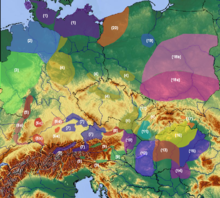Giant mug

Giant beaker is a morphological term in archeology for a rare form of pottery in the settlement ceramics of the single grave culture , which was found in the entire North German Plain (up to the Oder), but also in isolated cases south of it ( stone chamber grave of Züschen ).

The heterogeneous spectrum is determined exclusively by the size (about 35 to 56 cm) and the shape. The cups do not have an adequate footprint, they are undecorated, decorated flat or (especially in Wendland ) with plastic applications. The range of decorations for the giant cups was presented in 1955 by Karl Wilhelm Struve . Jan Lichardus formed four categories and postulated a closed cultural group belonging to the giant cup.
Giant beakers date from the transition from the late Neolithic to the early Bronze Age . The stratigraphic location of the giant beaker from the grave of Wallhöfen connects it with a burial of the bell beaker culture . This means that the giant and bell beakers must have been in use at the same time.
The early Bronze Age (1875 to 1575 BC) winding cord decoration is the key fossil of this period in Westphalia and the Netherlands.
literature
- Jonas Beran: Early Bronze Age . In: Guide to archaeological monuments in Germany 37 Potsdam, Brandenburg and the Havelland. 2000
- Jan Lichardus : On the problem of the giant cups and the early Bronze Age in the Hessian mountains. Find reports from Hessen 19/20, pp. 327–368.
- Karl Wilhelm Struve: The individual grave culture in Schleswig-Holstein and its continental relationships . K. Wachholtz, Neumünster 1955.
- Christian E. Schulz: Giant Cups in Westphalia GRN Verlag E-Book 2001